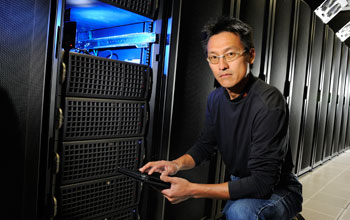Wu Feng accepts the Test of Time Award for his contribution on energy-efficient computing
Wu Feng, a professor at Virginia Tech, received recognition for his contributions at the Supercomputing 2022 International Conference for High Performance Computing, Networking, Storage, and Analysis in Dallas.
The 2005 study "A Power-Aware Run-Time System for High Performance Computing" on energy-efficient computing earned Feng and co-author Chung-hsing Hsu the Test of Time Award. The prize honors work in high-performance computing that has had a substantial historical effect and continues to influence the field's evolving paradigms.

This honor represents a sense of justice for Feng, who over 20 years ago presented his energy-efficient supercomputing idea to a skeptical and mocking audience due to the fact that not all innovation is quickly adopted and paradigms evolve slowly.
Three years prior to the publication of their prize-winning work, Feng and his co-authors presented their research on "High-Density Computing: A 240-Processor Beowulf in One Cubic Meter" at the ACM/IEEE Conference on Supercomputing in 2002. In this presentation, Green Destiny — a 240-node supercomputer with the size of a phone booth and a power consumption of just 3.2 kilowatts, or that of two hair dryers — was unveiled.
Supercomputers were constructed at the time like Formula 1 race cars, according to Feng. Although they were quick, they were also ineffective, unstable, and frequently in need of repair. Green Destiny was constructed more along the lines of a Nissan 370Z sports car (more efficient and reliable) and was nevertheless quite quick.
Feng lamented that it was nearly blasphemy to propose that top-end performance may be even somewhat reduced in order to preserve energy during a time when speed in supercomputing was the emphasis in the field. People left the room throughout his speech, and by the time it was over, the audience was even booing. The 2002 Computerworld article "Green Destiny draws cheers and jeers" discussed Feng's lecture.
Feng was further inspired by Green Destiny's unfavorable reaction in 2002 to develop a software solution that emphasized energy conservation without compromising the industry's demand for speed. By the Supercomputing 2005 conference, Feng and his crew had developed a software system that could distinguish between sizable blocks of computing and non-computing processes, such accessing memory or the network. The "Formula 1" supercomputer would run this Power-Aware Run-Time (PART) software system, which would convert it into a more dependable and energy-efficient "Nissan 370Z" by automatically adjusting the processing speed to the needs of the work at hand.
To simultaneously give speed and energy economy, the PART system "intelligently understands when and how to take its foot off the accelerator," according to Feng. The PART system, which conserves energy and maintains performance, is the final manifestation of the concepts that were first introduced in Green Destiny.
For now, Feng's study is finally acknowledged for changing high-performance computing trends. The energy-efficiency of modern supercomputers has increased by about 500-fold since Feng's study was initially published in 2005. Notably, the energy-efficient Frontier, the fastest supercomputer in the world right now, is a product of Feng's work and is housed in Tennessee's Oak Ridge National Laboratory.
After earning his Ph.D. in computer science from the University of Illinois at Urbana-Champaign in 1996 and splitting his time between the working world, government national labs, and higher education, Feng joined Virginia Tech's faculty in 2006.
As Feng shared, “I had been in academia before, but what pushed me to come to Virginia Tech was the collaborative environment for research, particularly across disciplines like computer science and aerospace engineering for computational fluid dynamics or computer science and biology for bioinformatics.”
Feng is the director of the Synergy Lab at Virginia Tech, the National Science Foundation Center for Space, High-performance, and Resilient Computing at Virginia Tech, and the Center for Synergistic Environments for Experimental Computing, in addition to teaching in the departments of computer science, electrical and computer engineering, and biomedical engineering and mechanics. Additionally, he founded Parallel Programming with Pictures, a program that uses images to teach the fundamentals of parallel computing to local middle and high school students from Southwest Virginia. To Feng, receiving this distinction means that his team contributed in some manner to promote a broader awareness to compute in a greener way. “We hope that this work and the overarching project continues to inspire research and innovation in green supercomputing.”
























